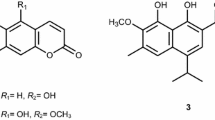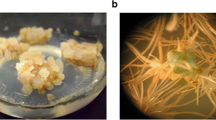Abstract
Anti-inflammatory effect of the alcoholic extracts of N. sativa seeds and its callus on mix glial cells of rat with regard to their thymoquinone (TQ) content was investigated. Callus induction was achieved for explants of young leaf, stem, petiole, and root of N. sativa on solid Murashige and Skoog (MS) medium containing 2,4-D (1 mg/l) and kinetin (2.15 mg/l). TQ content of the alcoholic extracts was measured by HPLC. Total phenols were determined using Folin–Ciocalteu method and antioxidant power was estimated using FRAP tests. The mix glial cells, inflamed by lipopolysaccharide, were subjected to anti-inflammatory studies in the presence of various amounts of TQ and the alcoholic extracts. Viability of the cells and nitric oxide production were measured by MTT and Griess reagent, respectively. The leaf callus obtained the highest growth rate (115.4 mg/day) on MS medium containing 2,4-D (0.22 mg/l) and kinetin (2.15 mg/l). Analyses confirmed that TQ content of the callus of leaf was 12 times higher than that measured in the seeds extract. However, it decreased as the calli aged. Decrease in the TQ content of the callus was accompanied with an increase in its phenolic content and antioxidant ability. Studies on the inflamed rat mix glial cells revealed significant reduction in the nitric oxide production in the presence of 0.2 to 1.6 mg/ml of callus extract and 1.25 to 20 μl/ml of the seed extracts. However, the extent of the effects is modified assumingly due to the presence of the other existing substances in the extracts.






Similar content being viewed by others
REFERENCES
Wyss-Coray T, Mucke L. Inflammation in neurodegenerative disease; a double-edged sword. Neuron. 2002;35:419–32.
Doherty GH. Nitric oxide in neurodegeneration: potential benefits of non-steroidal anti-inflammatories. Neurosci Bull. 2011;27(6):366–82.
Liu B, Gao HM, Wang JY, Jeohn GH, Cooper CL, Hong JS. Role of nitric oxide in inflammation mediated neurodegeneration. Ann N Y Acad Sci. 2002;962:318–31.
Mukeshwar P, Mousumi D, Shobit G, Surender KC. Phytomedicine: an ancient approach turning into future potential source of therapeutics. J Pharmacogn Phytother. 2011;3(3):27–37.
Sharrif Moghaddasi M. Nigella sativa treditional usages (Black Seed). Adv Environ Biol. 2011;5(1):5–16.
Khan MA. Chemical composition and medicinal properties of Nigella sativa Linn. Inflammopharmacology. 1999;7(1):15–35.
Ramadan MF, Orsel JTM. Characterization of phospholipid composition of black cumin (Nigella sativa L.) seed oil. Nahrung. 2002;46(4):240–4.
Nickavar B, Mojaba F, Javidniab K, Roodgar Amolia MA. Chemical composition of the fixed and volatile oils of Nigella sativa L. from Iran. Z Naturforsch C. 2003;58(9–10):629–31.
Randhawa MA. Black seed, Nigella sativa deserves more attention. J Ayub Med Coll Abbottabad. 2008;20(2):1–2.
Houghton PJ, Zarka R, de las Heras B, Hoult JR. Fixed oil of Nigella sativa and derived thymoquinone inhibit eicosanoid generation in leukocytes and membrane lipid peroxidation. Planta Med. 1995;61(1):33–6.
Nagi MN, Alam K, Badary OA, Al-Shabanah OA, Al-Sawaf HA, Al-Bekairi AM. Thymoquinone protects against carbon tetracholide hepatotoxicity in mice via an antioxidant mechanism. Biochem Mol Biol Int. 1999;47(1):153–9.
Burits M, Bucar F. Antioxidant activity of Nigella sativa essential oil. Phytother Res. 2000;14(5):323–8.
Kumara SS, Huat BT. Extraction, isolation and characterization of anti-tumour principle, alpha-hedrin, from the seeds of Nigella sativa. Planta Med. 2001;67(1):29–32.
Tekeoglu I, Dogan A, Demiralp L. Effects of thymoquinone (volatile oil of black cumin) on rheumatoid arthritis in rat models. Phytother Res. 2006;20(10):869–71.
Mansour MA, Tornhamre S. Thymoquinone inhibits 5-lipoxygenase and leukotriene C4 synthase in human blood cell. J Enzym Inhib Med Chem. 2004;19(5):431–6.
El Gazzar M, El Mezayen R, Marecki JC, Nicolls MR, Canastar A, Dreskin SC. Anti-inflammatory effect of thymoquinone in a mouse model of allergic lung inflammation. Int Immunopharmacol. 2006;6:1135–42.
Al-Ghamdi M. Anti–inflammatory, analgesic and anti-pyretic activity of Nigella sativa. J Ethnopharmacol. 2001;76:45–8.
Mahgoub AA. Thymoquinone protects against experimental colitis in rats. Toxicol Lett. 2003;143:133–43.
Xuan NT, Shumilina E, Qadri SM, Götz F, Lang F. Effect of thymoquinone on mouse dendritic cells. Cell Physiol Biochem. 2010;25:307–14.
Mohamed A, Shoker A, Bendjelloul F, Mare A, Alzrigh M, Benghuzzi H. Improvement of experimental allergic encephalomyelitis (EAE) by thymoquinone; an oxidative stress inhibitor. Biomed Sci Instrum. 2003;39:440–5.
Mahmoud M, Gilani A, Khwaja A, Rashid A, Ashfaq M. The in vitro effect of aqueous extract of Nigella sativa seeds on nitric oxide production. Phytother Res. 2003;17:921–4.
Banerjee S, Gupta S. Morphogenesis in tissue cultures of different organs of Nigella sativa. Physiol Plant. 1975;33:185–7.
Chand S, Roy SC. Study of callus tissues from different parts of Nigella sativa (Ranunculaceae). Experientia. 1979;36:305–6.
Al-Ani Nabeel K. Thymol production from callus culture of Nigella sativa L. Plant Tissue Cult Biotech. 2008;18(2):181–5.
Landa P, Maršík P, Vaněk T, Rada V, Kokoška L. In vitro anti-microbial activity of extracts from the callus cultures of some Nigella species. Biologia. 2006;61(3):285–8.
Murashige T, Skoog F. A revised medium for rapid growth and bioassay with tobacco tissue cultures. Physiol Plant. 1962;15:473–97.
Haghbeen K, Pourmolaei S, Mareftjo MJ, Mousavi A, Akbari Noghabi K, Hosseini Shirazi F, Meshkat A. Detailed investigations on the solid cell culture and antimicrobial activities of the Iranian Arnebia euchroma. J Biomed Biotechnol. 2011. doi:10.1155/2011/165852.
Singleton V, Orthofer R, Lamuela-Raventos RM. Analys of total phenol and other oxidation substrate and anti-oxidation by means of Folin Ciocalteu Reagent. Methods Enzymol. 1999;299:152–75.
Airis F, Strain J. Feric reducing: Direct measurment of total anti-oxidant activity of biologic fluid and modified version for simultaneous measurement of total antioxidant power and ascorbic acid concentration. Methods Enzymol. 1999;299:15–28.
Mosmann T. Rapid colorimetric assay for cellular growth and survival: application to proliferation and cytotoxicity assays. J Immunol Methods. 1983;65(1–2):55–63.
Grisham MB, Johnson GG, Lancaster JR. Quantitation of nitrate and nitrite in extracellular fluids. Methods Enzymol. 1996;268:237–46.
Elhag HM, El-Olemy MM, Al-Said MS. Enhancement of somatic embryogenesis and production of developmentally arrested embryogenesis in Nigella sativa L. HortScience. 2004;39(2):321–3.
Al-Said M, El-Olemy MM, Elhag HM. Biotechnological production of biologically active metabolites by plant cell culture techniques. Saudi Arabia: KACST; 2002. p. 218–56.
El-Tahir Kamal EH, Bakeet DM. The black seed Nigella sativa Linnaeus—a mine for multi cures: a plea for urgent clinical evaluation of its volatile oil. J T U Med Sci. 2006;1(1):1–19.
Salem LM. Immunomodulatory and therapeutic properties of the Nigella sativa L. seed. Int Immunopharmacol. 2005;5:1749–70.
Wooa CC, Kumar AP, Sethi G, Tan KHB. Thymoquinone: potential cure for inflammatory disorders and cancer. Biochem Pharmacol. 2012;83:443–51.
Pawate S, Bhat NR. Role of glia in CNS inflammation. Handbook of Neurochemistry and Molecular Neurobiology. New York: Springer; 2008. p. 309–30.
Nguyen MD, Julien JP, Rivest S. Innate immunity: the missing link in neuroprotection and neurodegeneration? Nat Rev Neurosci. 2002;3:216–27.
Farina C, Aloisi F, Meinl E. Astrocytes are active players in cerebral innate immunity. Trends Immunol. 2007;28(3):138–45.
Kong LY, McMillian MK, Hudson PM, Jin L, Hong JS. Inhibition of Lipopolysaccharide-induced nitric oxide and cytokine production by ultralow concentrations of dynorphins in mixed glia cultures. J Pharmacol Exp Ther. 1997;280:61–6.
Bielecka AM, Paul-Samojedny M, Obuchowicz E. Moclobemide exerts anti-inflammatory effect in lipopolysaccharide-activated primary mixed glial cell culture. Naunyn Schmiedeberg’s Arch Pharmacol. 2010. doi:10.1007/s00210-010-0535-4.
Liu W, Tang Y, Feng J. Cross talk between activation of microglia and astrocytes in pathological conditions in the central nervous system. Life Sci. 2011. doi:10.1016/j.lfs.2011.05.011.
Tripathy D, Grammas P. Acetaminophen inhibits neuronal inflammation and protects neurons from oxidative stress. J Neuroinflammation. 2009;6(10). doi:10.1186/1742-2094-6-10.
Crocoll C. Biosynthesis of the phenolic monoterpenes, thymol and carvacrol, by terpene synthases and cytochrome P450s in oregano and thyme (Dissertation). Max-Planck-Institut für chemische Ökologie. Jena; 2010. pp. 1–151.
ACKNOWLEDGMENTS
This study was supported by National Institute of Genetic Engineering and Biotechnology, Tehran, Iran.
Author information
Authors and Affiliations
Corresponding author
Rights and permissions
About this article
Cite this article
Alemi, M., Sabouni, F., Sanjarian, F. et al. Anti-inflammatory Effect of Seeds and Callus of Nigella sativa L. Extracts on Mix Glial Cells with Regard to Their Thymoquinone Content. AAPS PharmSciTech 14, 160–167 (2013). https://doi.org/10.1208/s12249-012-9899-8
Received:
Accepted:
Published:
Issue Date:
DOI: https://doi.org/10.1208/s12249-012-9899-8




